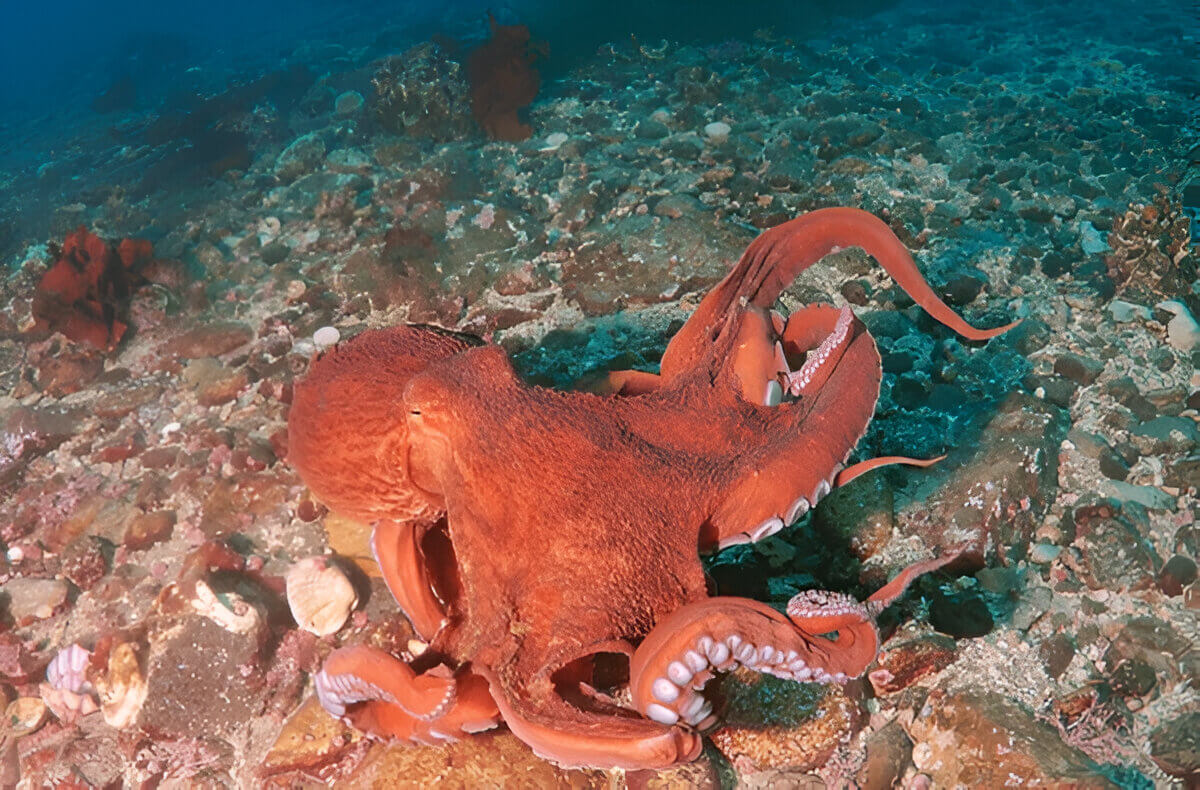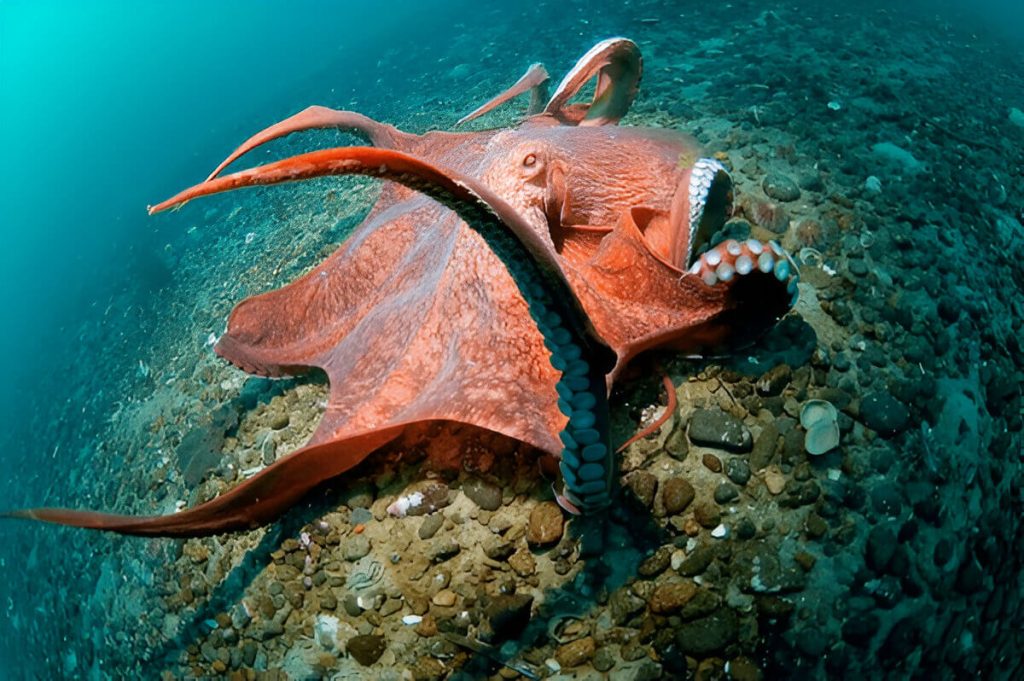
Beneath the Pacific Ocean waves is the Giant Pacific Octopus, a marvel of size and intelligence. As the largest octopus species, it impresses with unique adaptations and complex behaviors, from camouflage to problem-solving. This text explores its physical traits, cognitive skills, lifecycle, diet, and essential conservation efforts needed for its protection against environmental threats. Discover the mysteries of this intriguing ocean giant.
Physical Characteristics and Adaptations
Octopuses are fascinating creatures, renowned for their unique physical characteristics and remarkable adaptations that allow them to thrive in diverse marine environments. One of the most striking features of octopuses is their size and weight, which can vary significantly across different species. Generally, octopuses range from a few centimeters to several meters in length, with weights spanning from less than a pound to over 150 pounds for the giant Pacific octopus.
A key adaptation that sets octopuses apart is their extraordinary camouflage abilities. Their skin contains specialized cells called chromatophores, which can rapidly change color and pattern to blend seamlessly with their surroundings. This ability not only helps them avoid predators but also aids in ambushing prey by providing the perfect disguise.
The texture of an octopus’s skin further enhances its camouflage capabilities. The skin is highly flexible and covered in tiny bumps known as papillae, allowing it to mimic the textures of rocks, coral, or sand. This adaptability makes it nearly impossible for predators or prey to detect them when they remain motionless.
Beyond camouflage, octopuses possess other adaptive features that contribute to their survival. Their soft bodies enable them to squeeze through incredibly tight spaces, while their highly developed nervous systems grant them exceptional problem-solving skills and memory retention. These combined traits make octopuses some of the most adaptable and intelligent invertebrates in the oceanic realm.
The Intelligent Mind of the Giant Pacific Octopus
The Giant Pacific Octopus is renowned for its remarkable intelligence, a trait that has fascinated researchers and marine enthusiasts alike. Among the intriguing octopus intelligence facts is their exceptional problem-solving ability, which rivals that of many land animals. These cephalopods have been observed manipulating objects to navigate mazes, open jars to access food, and even escape enclosures, demonstrating an impressive level of cognitive skill.
One of the key aspects of their intelligence is their learning behavior. Unlike many sea creatures that rely solely on instinct, Giant Pacific Octopuses can learn from experience and adapt to new situations. This adaptability is evident in their ability to remember solutions to puzzles and apply these solutions to similar challenges in the future.
The cognitive skills of Giant Pacific Octopuses extend beyond problem-solving; they also exhibit complex behaviors such as playfulness and curiosity. These behaviors suggest a depth of mental processing that sets them apart from other marine life forms. As research continues, understanding these intelligent cephalopods not only sheds light on the evolutionary capabilities of oceanic species but also broadens our perspective on animal cognition as a whole.
Lifespan and Reproduction (The Circle of Life Underwater)

The underwater world is home to a fascinating array of life forms, and among the most intriguing are octopuses. These intelligent cephalopods lead lives that are as complex as they are captivating, particularly when it comes to their lifespan and reproduction. Understanding the octopus lifespan details reveals that these creatures generally have short lifespans, often ranging from six months to five years depending on the species. The giant Pacific octopus, for instance, is one of the longer-lived species, with a lifespan that can extend up to five years.
Reproduction in octopuses is an equally intricate affair. The reproductive cycle of octopuses begins with a unique mating ritual where males use a specialized arm called a hectocotylus to transfer sperm packets into the female’s mantle cavity. This process is not only crucial for reproduction but also marks the beginning of significant changes in both male and female octopuses.
After mating, females embark on an extraordinary journey of motherhood. The giant Pacific octopus lays thousands of eggs in a secluded den, where she devotes herself entirely to their care. During this period, which can last several months, she meticulously cleans and aerates her eggs while refraining from eating, a testament to her dedication. Once the eggs hatch into tiny hatchlings resembling miniature adults, they drift into the open ocean as plankton before eventually settling down into their benthic lifestyle.
This entire reproductive process underscores the unique mating habits in cephalopods and highlights how integral reproduction is to completing their lifecycle despite its brevity. Each stage (from courtship through hatching) demonstrates nature’s remarkable ability to adapt and thrive even under challenging circumstances beneath the waves.
The Diet and Hunting Techniques of a Master Predator
The giant Pacific octopus is a fascinating creature, renowned for its intelligence and adaptability in the diverse marine environment. Understanding its diet and hunting techniques offers a glimpse into the sophisticated strategies employed by this master predator.
When it comes to diet, the giant Pacific octopus is an opportunistic feeder with a varied palate. Its diet includes shrimp, crabs, clams, lobsters, and even small fish. These octopuses are also known to prey on other cephalopods and occasionally scavenge on dead animals. This diversity in food sources highlights their ability to adapt to different conditions within their habitat.
Hunting strategies in marine life can be complex and varied, but few match the ingenuity of the giant Pacific octopus. One of their most remarkable prey capture methods involves using their highly flexible arms equipped with sensitive suckers that can detect chemical signals from potential prey. This allows them to explore crevices and rocky outcroppings where many of their meals hide.
In addition to physical prowess, these octopuses exhibit remarkable problem-solving skills when hunting. They have been observed opening jars or manipulating objects to access food, a testament to their cognitive abilities undersea.
Feeding habits undersea for these creatures involve not only capturing but also efficiently consuming prey. Once captured, they use their sharp beaks to penetrate hard shells of crustaceans or mollusks before secreting digestive enzymes that help break down the meal for easier consumption.
Overall, the giant Pacific octopus exemplifies how evolution has fine-tuned specific adaptations for survival in challenging environments through a combination of dietary flexibility and sophisticated hunting techniques, making it one of nature’s most adept predators undersea.
The Importance of Conservation Efforts for the Giant Pacific Octopus Populace
The Giant Pacific Octopus, a fascinating and intelligent marine creature, plays a crucial role in the ocean’s ecosystem. However, like many other marine species, it faces numerous threats that have led to growing concerns about its population sustainability. Conservation efforts are essential to protect this unique species and maintain the delicate balance of ocean life.
The threats to Giant Pacific Octopi populations are varied and complex. Overfishing is one of the primary dangers, as these creatures are often caught unintentionally in fishing nets targeting other species. Additionally, habitat destruction caused by coastal development and pollution further exacerbates their vulnerability. Climate change also poses a significant threat by altering ocean temperatures and acidity levels, which can disrupt their natural habitats.
Conservation efforts for endangered marine species like the Giant Pacific Octopus focus on several key strategies. Implementing sustainable fishing practices is crucial to minimize bycatch and ensure that octopus populations are not depleted faster than they can reproduce. Protecting critical habitats through marine protected areas can help safeguard essential breeding grounds from human interference.
Moreover, raising public awareness about the environmental impact on ocean life is vital for fostering support for conservation initiatives. By educating communities about the importance of preserving these creatures and their ecosystems, we can encourage more responsible behavior towards our oceans.
Conserving the Giant Pacific Octopus is not just about saving a single species; it is about maintaining biodiversity and ensuring healthy oceans for future generations. Through dedicated conservation efforts addressing both direct threats and broader environmental impacts, we can work towards a more sustainable future for all marine life.
The Future for Giant Pacific Octopi and Their Role in Marine Ecosystems
The future of giant Pacific octopi holds significant implications for marine ecosystems. These remarkable creatures play a crucial role in maintaining the balance of their underwater habitats. As apex predators, they regulate the populations of various species, ensuring that no single group dominates. This helps to maintain biodiversity and supports healthy oceanic environments.
Moreover, giant Pacific octopi contribute to nutrient cycling within marine ecosystems. By preying on different organisms and being preyed upon by others, they facilitate the transfer of energy and nutrients through different trophic levels. This process is vital for sustaining the complex web of life found beneath the waves.
However, threats such as climate change, pollution, and overfishing pose serious challenges to their survival. Rising ocean temperatures can alter their habitats and food availability, while pollution can degrade their environment and health. Overfishing not only reduces their prey but also increases competition with humans for seafood resources.
To safeguard these incredible animals and their ecological roles, it is essential to implement effective conservation strategies. Protecting critical habitats through marine reserves and reducing human impacts on oceans are crucial steps towards ensuring that giant Pacific octopi continue to thrive in our seas. By doing so, we preserve not only a fascinating species but also the intricate balance of life that depends on them within marine ecosystems worldwide.